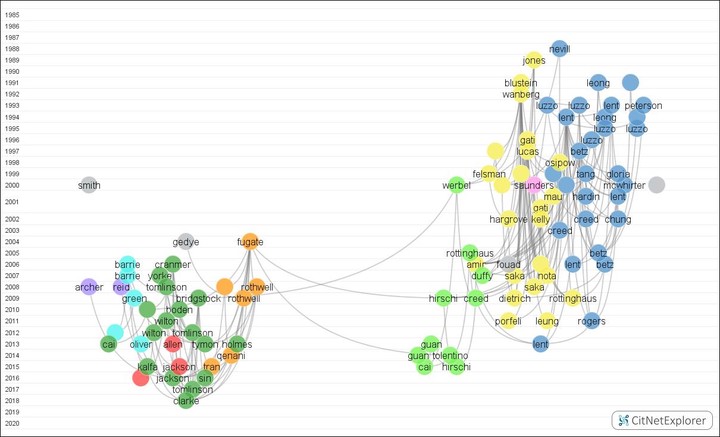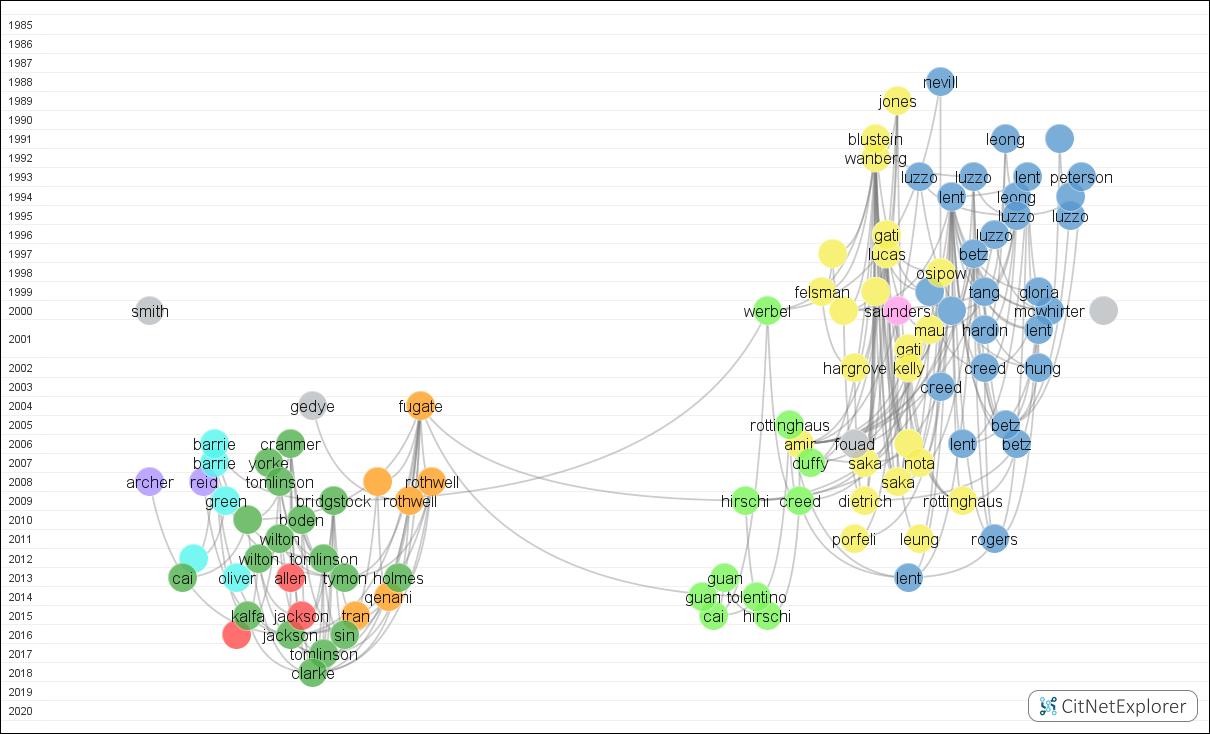Why don't graduate employability and career development research talk to each other?
 A citation network map of graduate employability and career development research.
A citation network map of graduate employability and career development research.Register at this link to attend my webinar “Mapping graduate employability and career development in higher education research”, on Wednesday October 28, 2020 at 07:00 PM Australian Eastern Standard Time.
On behalf of my co-authors Sara Hammer and Peter McIlveen, I’m pleased to share our article “Mapping graduate employability and career development in higher education research: A citation network analysis”, published this week in Studies in Higher Education. This is a major milestone for me, as it’s my first journal article as first author and the first publication of my PhD by publication portfolio.
In the article, we present visualisations of direct citation networks among 4068 journal articles focused on graduate employability and career development. We show that despite the clear alignment of research concerns and educational goals, there has been limited theoretical or practical exchange between the two fields. We argue that purposeful exchange between the two fields can inform an evidence-based, integrative pedagogy of careers and employability learning in higher education.
What it means
Our main point is summed up in Figure 1, showing a direct citation network map of journal articles about graduate employability (on the left) and career development (on the right). It’s clear that for the most part, the two fields do not interact much.

In the article, we describe distinct research themes within the two fields. In the field of graduate employability, we see clusters of research focused on graduate employability in general, professional identities, graduate attributes, perceived employability, and workplace learning. In the career development field, we see clusters of research focused on career exploration, decision-making, and self-management; career decision-making difficulties; career orientations, such as adaptability and optimism; career development barriers; and biomedical career development.
However, the two fields are not entirely unconnected. The most exchange is found in the perceived employability and career orientations clusters, from authors such as Yehuda Baruch, William Donald, Denise Jackson, Silvia Monteiro, Belgin Okay-Somerville, Michael Tomlinson, and their colleagues.
Why we wrote it
In my my professional life as a university careers and employability educator, I have sometimes been perplexed and frustrated by the total absence of leading career development theories in employability research and education. In our article, we argue that this gap presents a risk to the quality and cohesion of pedagogical and strategic efforts to support students’ employability and career development. Certainly, the disjuncture allows for the “jingle jangle” fallacy to emerge, in which researchers from different fields apply the same names to distinct concepts, or distinct names to the same concepts. Either way, the result can be duplication of effort and impediments to integrative insights.
How we wrote it
Our analysis was done with a nifty little tool called CitNet Explorer, which takes a plain text export of search results from the Web of Science database, analyses the direct citation networks between publications, and displays the results in a citation network map. You can then do all sorts of additional analyses to explore themes or boundaries in the research, trace seminal ideas, and identify key authors and journals.
As this article is to be part of my PhD portfolio, I managed the project from start to finish and did the lion’s share of the actual writing. I worked almost entirely in a plain text writing workflow, using Obsidian for note-taking, Zettlr markdown editor for writing, Zotero for citation management, and GitKraken for version control. I only converted my markdown files to Word documents when I was soliciting contributions and feedback from my co-authors or submitting the final manuscript and revisions.
What’s up next
Because this article is to be part of my PhD by publication portfolio, it needs to fit into a broader research project. In my case, that project is to articulate an integrated pedagogy of careers and employability learning in higher education. This article is an analysis of the research literature, in the form of journal articles, and in particular, the gap between graduate employability and career development.
My second article, which is currently being drafted in partnership with my peers Jason Brown and Candy Ho, focuses on the professional practice of careers and employability in higher education. We have analysed 400 university job descriptions focused on careers and employability. Similarly to the citation network analysis described above, the results show a clear distinction between career development roles, mostly in university careers services, and a broad range of employability roles, including student engagement, student life, work-integrated learning, and alumni, to name a few. We will analyse these roles as an “ecology” of various professions in complex, sometimes competing, relationships with each other and university management.
Of course, I’ll enthusiastically share this second article once it’s published. I appreciate everyone’s ongoing support, encouragement and interest in my research. I hope that it resonates with my peers and makes some small impact in the world of higher education careers and employability learning.